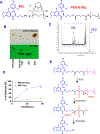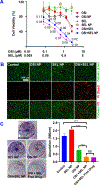Nanoparticles for co-delivery of osimertinib and selumetinib to overcome osimertinib-acquired resistance in non-small cell lung cancer
- PMID: 34048974
- PMCID: PMC8273131
- DOI: 10.1016/j.actbio.2021.05.018
Nanoparticles for co-delivery of osimertinib and selumetinib to overcome osimertinib-acquired resistance in non-small cell lung cancer
Abstract
Osimertinib (OSI) is the first FDA-approved third-generation epidermal growth factor receptor (EGFR) tyrosine kinase inhibitor (TKI). It can be used for treating non-small cell lung cancer (NSCLC) patients with activating EGFR mutation and for patients who are resistant to first-generation EGFR TKIs due to T790M resistance mutation. However, patients treated with OSI ultimately develop acquired resistance, which prevents its long-term benefit for patients. Therefore, the development of effective strategies to overcome OSI resistance will address a significant clinical challenge and benefit patients by prolonging their survival time. Our previous studies indicated that combination therapy was a promising strategy for overcoming OSI resistance. In this study, we developed nanoparticle (NP) formulations for co-delivery of osimertinib (OSI) and selumetinib (SEL) to treat OSI-resistant NSCLC effectively. We conjugated SEL with PEG through a reactive oxygen species (ROS)-responsive linker to generate polyethylene glycol (PEG)-SEL conjugate prodrug (PEG-S-SEL). Due to the amphiphilic nature of PEG-S-SEL, it can self-assemble in an aqueous solution to form micelle NP and serve as a delivery carrier for OSI. The ROS-responsive linker can facilitate the release of drugs in the tumor microenvironment with elevated ROS levels. OSI and SEL combination NP can overcome OSI resistance by simultaneously inhibiting both EGFR and mitogen-activated protein kinase (MEK), thus effectively inducing apoptosis in OSI-resistant NSCLC cells and inhibiting OSI-resistant tumors in vivo. In conclusion, the OSI+SEL NP combination therapy showed promising anticancer efficacy and demonstrated potential for treating NSCLC patients with OSI acquired resistance. STATEMENT OF SIGNIFICANCE: Osimertinib (OSI) is the first FDA-approved third-generation epidermal growth factor receptor (EGFR) tyrosine kinase inhibitor. It has been successfully used for treating non-small cell lung cancer (NSCLC) patients with activating EGFR mutation. However, patients treated with OSI ultimately develop acquired resistance. This study developed OSI and selumetinib (SEL) co-delivering nanoparticles to overcome OSI-acquired resistance in NSCLC. PEG-SEL conjugate functions as reactive oxygen species (ROS)-responsive prodrug and forms micelle nanoparticles through self-assembly to deliver OSI. The combination NP can simultaneously inhibit EGFR and mitogen-activated protein kinase (MEK), thus effectively inducing apoptosis in OSI-resistant NSCLC cells. In summary, the OSI and SEL nanoparticle combination therapy showed promising anticancer efficacy and demonstrated potential for treating NSCLC patients with OSI acquired resistance.
Keywords: Acquired resistance; Non-small Cell Lung Cancer; Osimertinib; Prodrug; Reactive Oxygen Species; Selumetinib.
Copyright © 2021 Acta Materialia Inc. Published by Elsevier Ltd. All rights reserved.
Conflict of interest statement
Declaration of Competing Interest The authors declare that they have no known competing financial interests or personal relationships that could have appeared to influence the work reported in this paper.
Figures






Similar articles
-
ERK inhibition effectively overcomes acquired resistance of epidermal growth factor receptor-mutant non-small cell lung cancer cells to osimertinib.Cancer. 2020 Mar 15;126(6):1339-1350. doi: 10.1002/cncr.32655. Epub 2019 Dec 10. Cancer. 2020. PMID: 31821539 Free PMC article.
-
Activation of insulin-like growth factor-1 receptor confers acquired resistance to osimertinib in non-small cell lung cancer with EGFR T790M mutation.Thorac Cancer. 2020 Jan;11(1):140-149. doi: 10.1111/1759-7714.13255. Epub 2019 Nov 22. Thorac Cancer. 2020. PMID: 31758670 Free PMC article.
-
Dihydroartemisinin overcomes the resistance to osimertinib in EGFR-mutant non-small-cell lung cancer.Pharmacol Res. 2021 Aug;170:105701. doi: 10.1016/j.phrs.2021.105701. Epub 2021 Jun 1. Pharmacol Res. 2021. PMID: 34087353
-
Osimertinib resistance in non-small cell lung cancer: Mechanisms and therapeutic strategies.Cancer Lett. 2018 Apr 28;420:242-246. doi: 10.1016/j.canlet.2018.02.004. Epub 2018 Feb 7. Cancer Lett. 2018. PMID: 29425688 Review.
-
Osimertinib: A third-generation tyrosine kinase inhibitor for treatment of epidermal growth factor receptor-mutated non-small cell lung cancer with the acquired Thr790Met mutation.J Oncol Pharm Pract. 2018 Jul;24(5):379-388. doi: 10.1177/1078155217712401. Epub 2017 May 31. J Oncol Pharm Pract. 2018. PMID: 28565936 Review.
Cited by
-
Smart Nanotherapeutics and Lung Cancer.Pharmaceutics. 2021 Nov 20;13(11):1972. doi: 10.3390/pharmaceutics13111972. Pharmaceutics. 2021. PMID: 34834387 Free PMC article. Review.
-
Progress on angiogenic and antiangiogenic agents in the tumor microenvironment.Front Oncol. 2024 Nov 19;14:1491099. doi: 10.3389/fonc.2024.1491099. eCollection 2024. Front Oncol. 2024. PMID: 39629004 Free PMC article. Review.
-
Optimizing Osimertinib for NSCLC: Targeting Resistance and Exploring Combination Therapeutics.Cancers (Basel). 2025 Jan 29;17(3):459. doi: 10.3390/cancers17030459. Cancers (Basel). 2025. PMID: 39941826 Free PMC article. Review.
-
Recent Developments in Tyrosine Kinase Inhibitor-based Nanotherapeutics for EGFR-resistant Non-small Cell Lung Cancer.Curr Drug Deliv. 2025;22(3):249-260. doi: 10.2174/0115672018278617231207051907. Curr Drug Deliv. 2025. PMID: 38275043 Review.
-
Co-delivery of sorafenib and crizotinib encapsulated with polymeric nanoparticles for the treatment of in vivo lung cancer animal model.Drug Deliv. 2021 Dec;28(1):2108-2118. doi: 10.1080/10717544.2021.1979129. Drug Deliv. 2021. PMID: 34607478 Free PMC article.
References
-
- Siegel RL, Miller KD, Jemal A, Cancer statistics, 2018, CA: A Cancer Journal for Clinicians 68 (2018) 7–30. - PubMed
-
- Lim SM, Syn NL, Cho BC, Soo RA, Acquired resistance to EGFR targeted therapy in non-small cell lung cancer: Mechanisms and therapeutic strategies, Cancer Treat Rev 65 (2018) 1–10. - PubMed
-
- Cross DA, Ashton SE, Ghiorghiu S, Eberlein C, Nebhan CA, Spitzler PJ, Orme JP, Finlay MR, Ward RA, Mellor MJ, Hughes G, Rahi A, Jacobs VN, Red Brewer M, Ichihara E, Sun J, Jin H, Ballard P, Al-Kadhimi K, Rowlinson R, Klinowska T, Richmond GH, Cantarini M, Kim DW, Ranson MR, Pao W, AZD9291, an irreversible EGFR TKI, overcomes T790M-mediated resistance to EGFR inhibitors in lung cancer, Cancer Discov 4 (2014) 1046–61. - PMC - PubMed
-
- Ramalingam SS, Vansteenkiste J, Planchard D, Cho BC, Gray JE, Ohe Y, Zhou C, Reungwetwattana T, Cheng Y, Chewaskulyong B, Shah R, Cobo M, Lee KH, Cheema P, Tiseo M, John T, Lin MC, Imamura F, Kurata T, Todd A, Hodge R, Saggese M, Rukazenkov Y, Soria JC, Overall Survival with Osimertinib in Untreated, EGFR-Mutated Advanced NSCLC, N Engl J Med 382 (2020) 41–50. - PubMed
Publication types
MeSH terms
Substances
Grants and funding
LinkOut - more resources
Full Text Sources
Other Literature Sources
Medical
Research Materials
Miscellaneous

